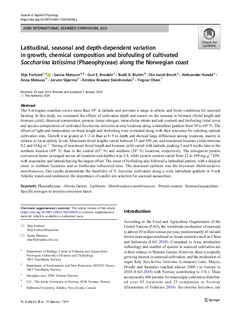| dc.contributor.author | Forbord, Silje | |
| dc.contributor.author | Matsson, Sanna | |
| dc.contributor.author | Brodahl, Guri Ellila | |
| dc.contributor.author | Bluhm, Bodil | |
| dc.contributor.author | Broch, Ole Jacob | |
| dc.contributor.author | Handå, Aleksander | |
| dc.contributor.author | Metaxas, Anna | |
| dc.contributor.author | Skjermo, Jorunn | |
| dc.contributor.author | Steinhovden, Kristine | |
| dc.contributor.author | Olsen, Yngvar | |
| dc.date.accessioned | 2020-02-07T14:00:38Z | |
| dc.date.available | 2020-02-07T14:00:38Z | |
| dc.date.created | 2020-01-24T08:34:51Z | |
| dc.date.issued | 2020 | |
| dc.identifier.citation | Journal of Applied Phycology. 2020, . | nb_NO |
| dc.identifier.issn | 0921-8971 | |
| dc.identifier.uri | http://hdl.handle.net/11250/2640489 | |
| dc.description.abstract | The Norwegian coastline covers more than 10° in latitude and provides a range in abiotic and biotic conditions for seaweed farming. In this study, we compared the effects of cultivation depth and season on the increase in biomass (frond length and biomass yield), chemical composition (protein, tissue nitrogen, intracellular nitrate and ash content) and biofouling (total cover and species composition) of cultivated Saccharina latissima at nine locations along a latitudinal gradient from 58 to 69° N. The effects of light and temperature on frond length and biofouling were evaluated along with their relevance for selecting optimal cultivation sites. Growth was greater at 1–2 m than at 8–9 m depth and showed large differences among locations, mainly in relation to local salinity levels. Maximum frond lengths varied between 15 and 100 cm, and maximum biomass yields between 0.2 and 14 kg m−2. Timing of maximum frond length and biomass yield varied with latitude, peaking 5 and 8 weeks later in the northern location (69° N) than in the central (63° N) and southern (58° N) locations, respectively. The nitrogen-to-protein conversion factor (averaged across all locations and depths) was 3.8, while protein content varied from 22 to 109 mg g−1 DW, with seasonality and latitude having the largest effect. The onset of biofouling also followed a latitudinal pattern, with a delayed onset in northern locations and at freshwater-influenced sites. The dominant epibiont was the bryozoan Membranipora membranacea. Our results demonstrate the feasibility of S. latissima cultivation along a wide latitudinal gradient in North Atlantic waters and underscore the importance of careful site selection for seaweed aquaculture. | nb_NO |
| dc.language.iso | eng | nb_NO |
| dc.publisher | Springer Verlag | nb_NO |
| dc.relation.uri | https://link.springer.com/article/10.1007/s10811-020-02038-y | |
| dc.rights | Navngivelse 4.0 Internasjonal | * |
| dc.rights.uri | http://creativecommons.org/licenses/by/4.0/deed.no | * |
| dc.title | Latitudinal, seasonal and depth-dependent variation in growth, chemical composition and biofouling of cultivated Saccharina latissima (Phaeophyceae) along the Norwegian coast | nb_NO |
| dc.type | Journal article | nb_NO |
| dc.type | Peer reviewed | nb_NO |
| dc.description.version | publishedVersion | nb_NO |
| dc.source.pagenumber | 18 | nb_NO |
| dc.source.journal | Journal of Applied Phycology | nb_NO |
| dc.identifier.doi | 10.1007/s10811-020-02038-y | |
| dc.identifier.cristin | 1781237 | |
| dc.relation.project | Norges forskningsråd: 254883 | nb_NO |
| dc.description.localcode | Open Access This article is licensed under a Creative Commons Attribution 4.0 International License. | nb_NO |
| cristin.unitcode | 194,66,10,0 | |
| cristin.unitname | Institutt for biologi | |
| cristin.ispublished | true | |
| cristin.fulltext | original | |
| cristin.qualitycode | 1 | |

